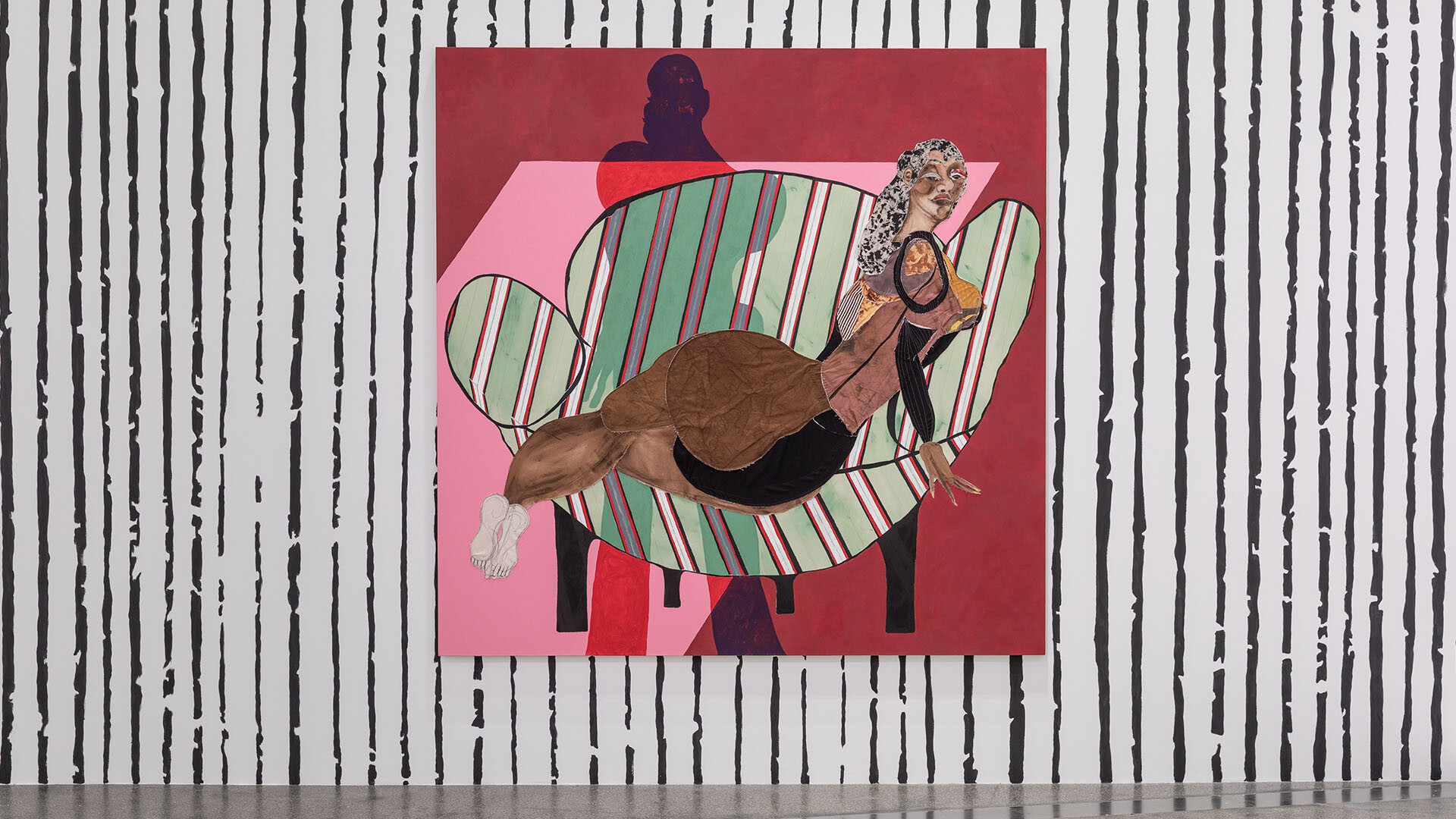110%: Wet Nurse
David Wlazlo
Often we think about and experience art through the structures of cause and effect. Art, it seems, easily slips into being understood as an effect of some prior cause: the artist is perhaps the most basic causal beginning, and also—digging deeper—the artist’s intention, mental health, personal interests, social and economic biography, and even their presumed ‘bio-sexual’ status can also be brought forth in order to explain and understand the artwork. The artwork is then conceived as an effect of these causal structures. Another common strategy is to align the artwork within a socially accepted (and constructed) narrative: the long chain of art-historical connections, progressions and causes, effects, negations, explorations and critiques, which become part of an accepted drama within which formal qualities as well as conceptual tendencies can play a part.
While the ‘narrative arc’ within this drama becomes the most basic unit of the historical approach (‘History’—and the full breadth of this term is hard to overstate—is rendered into artistic style or tendency), it is harder to define the most reduced factor in the search for the artist as bodily, biological, and subjective cause. Art and the artist as an effect of history seems a fairly straightforward model, but is it possible to pinpoint a biological position whereby the artist, as perhaps a primary cause of the artwork, is defined by their education, or their class, or their parents, or their diet, or their psychology, or indeed their gut biome? What I mean is this: if we uphold that the artist is one of the basic causes of an artwork, can we also include the microbacterial and microfungal inhabitants of that artist’s body within the causal network that we impose? If not, why not? Where does an artist—who is, in spite of what they sometimes think of themselves, just another type of person—begin and end?

110% is an artist collective whose three members (Kieran Bryant, Beth Dillon and Lachlan Herd) recently performed Wet Nurse. The performance was energetic, wet, bodily, engrossing and almost psychedelic in its approach to the microbiological aspects of bread making, breast feeding and the labour of kneading and expressing in order to care and nurture.
110% describe Wet Nurse as demonstrating “choreographies of caregiving through interspecies collaboration, focusing on intimate contact zones between fermentative microorganisms, and the bodies of artists and audiences.” Traditionally, to be a ‘wet nurse’ is to care and suckle the child of another, combining physical intimacy and nourishment with the necessities of caregiving, labour and (of course) potential class imbalances. Breast milk substitute or ‘formula’—itself the object of a vital international trade since the ‘2008 Chinese milk scandal’—has to a large degree done away with the messy physical and social implications of sharing one’s body with the child of another. However, with the health benefits of breast feeding broadly accepted, the idea of a wet nurse does not seem so medieval a solution anymore for those whose own lactation does not provide or develop enough. The potential remains, as with most of these transferences of labour, that what is a necessity for some may be a choice for others: it is traditionally poorer women who wet-nurse the children of the rich. Writing this now, I can imagine the inverse occurring today: the boutique, the hipster, the bespoke wet nurse operating in the ‘gig economy’ via some mobile app. Of course, this model just attempts to portray economically desperate measures as socially dynamic, and I will leave it to the reader to workshop the name of the fictitious app to express full dynamism-slash-desperation.

The idea of the wet nurse, then, invokes ideas of physical intimacy with ‘foreign’ organisms, of temporary labour, and of a relationship that can be both symbiotic and exploitative. In the case of Wet Nurse, the foreign organisms are the yeast cultures developed by the artists in three different locations: Sydney, Melbourne and Bienne (Switzerland). These yeast cultures were developed, cared for and ‘fed’ until they became what’s known as the ‘mother’: a dough that can be divided and used as a starter culture for the making of bread.
Wall texts and drawings in the first gallery show microscopic images of yeast, a quote about the symbiotic relationship between humans and microbes, wall drawings showing aspects of the performance to come, and a print out of an email from a friend of one of the artists, who recounts their labour as a cleaner in one of Australia’s so-called ‘gay sex saunas’. While men had anonymous sexual encounters in these night-club-like environments, this worker furtively scanned the rooms, torch in hand, cleaning up the spectrum of waste that would accumulate. Art historian David Joselit once remarked that certain forms of gay and queer activism constituted a critique of the normative and privileged model of biological production. Gay sex, in this schema, is a kind of ‘dispersal without production’, a dissemination of genetic information that does not ‘produce’. While these non-normative modes of biological production do not re-produce the species in any direct way, the humid mess described by this anonymous worker suggests that although ‘human babies’ are not produced in these encounters, fertile microbial material life is produced. Another wall contains a close-up video of dough fermenting, and in a nearby room is a hanging sculptural object that functions as a breeding ground—or perhaps nursery—for the various dough’s produced and reproduced by the three mothers.
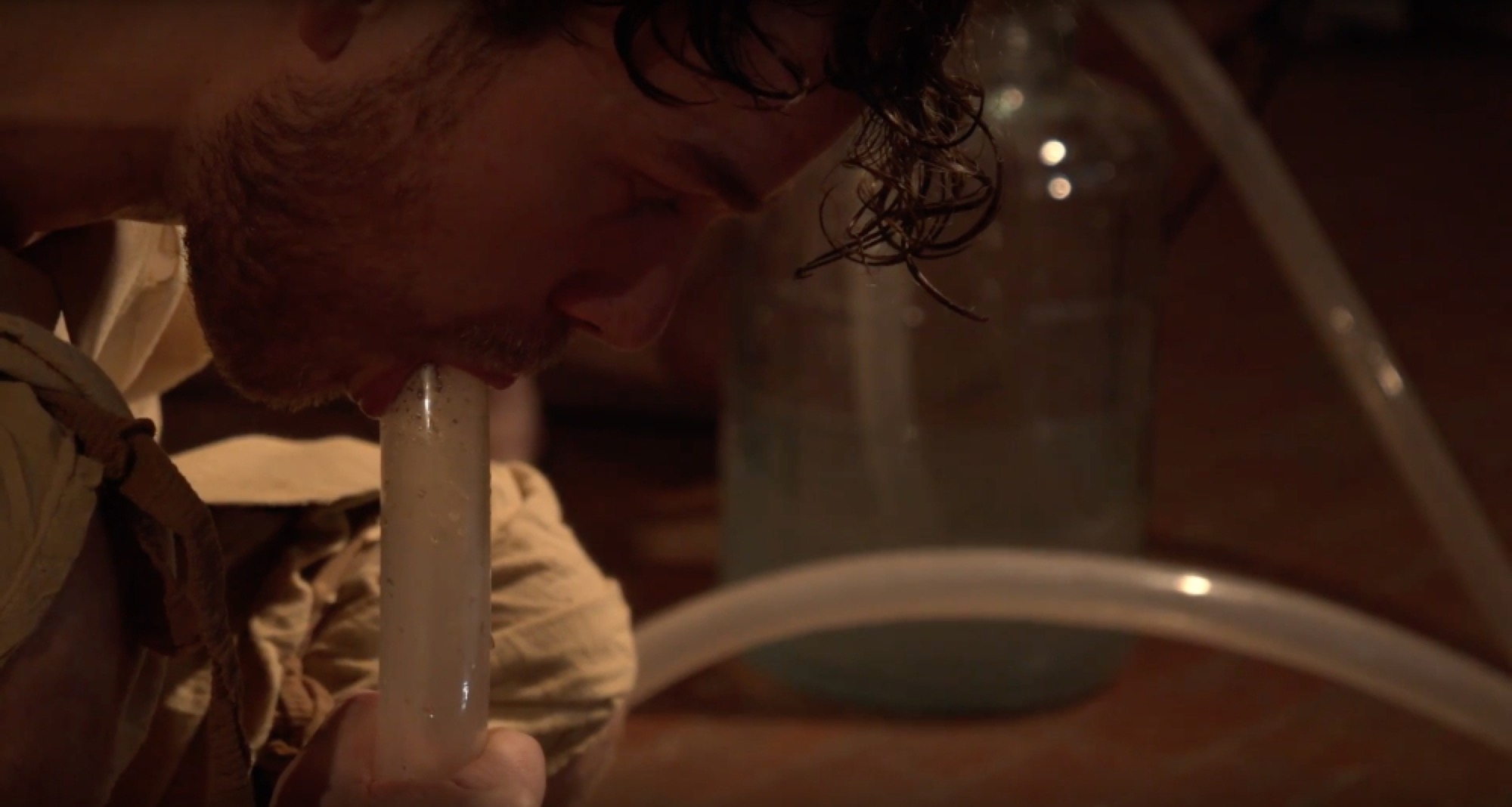
The performance developed across a series of five scenes, each of which emerges as a picture in which the labour of kneading and feeding dough mixes with ideas of contamination and symbiosis.
After a muslin curtain was pulled back, the artists were found lying or reclining on the floor. Dressed in slightly yellowed, shellac-coloured clothing that matched the curtain, they were each rubbing, kneading, sharing and rolling dough between each other, their feet and toes, and binding this dough to themselves with sheer stockings. This went on for some time, until one of the artists took their dough to the adjoining room, where a flexible clear plastic sheet was stretched horizontally across the room by elasticised rope. There the dough was rolled on the plastic sheet and then thrown across to another performer, who took part in the process of rolling, kneading, and throwing back as though in a game. The third performer took part, walking underneath the plastic and sharing their hair with the residue of the dough. Throughout this process, the dough—which is by now the object of care and labour—fell onto the floor a number of times. Once the dough had been through this process, the artists regrouped to a smaller area. This area housed two vessels of unclear-water and a clear-acrylic syphoning hose. One artist sucked the water from one jar into their mouth, then spat it into the second jar while another held the hose steady alongside a microphone which merged the growling and gurgling of the syphoning process with the music (throughout the performance, electronic music was performed live by sound artist Endurie, who unobtrusively sat in the corner). In the background, the third artist emerged topless, holding a medium sized unframed mirror. They placed the dough at the base of this mirror on the floor, and then proceeded to express breast milk onto the mirror, which trickled down into and onto the dough. While this expression was going on, the performer watched the others through the mirror.
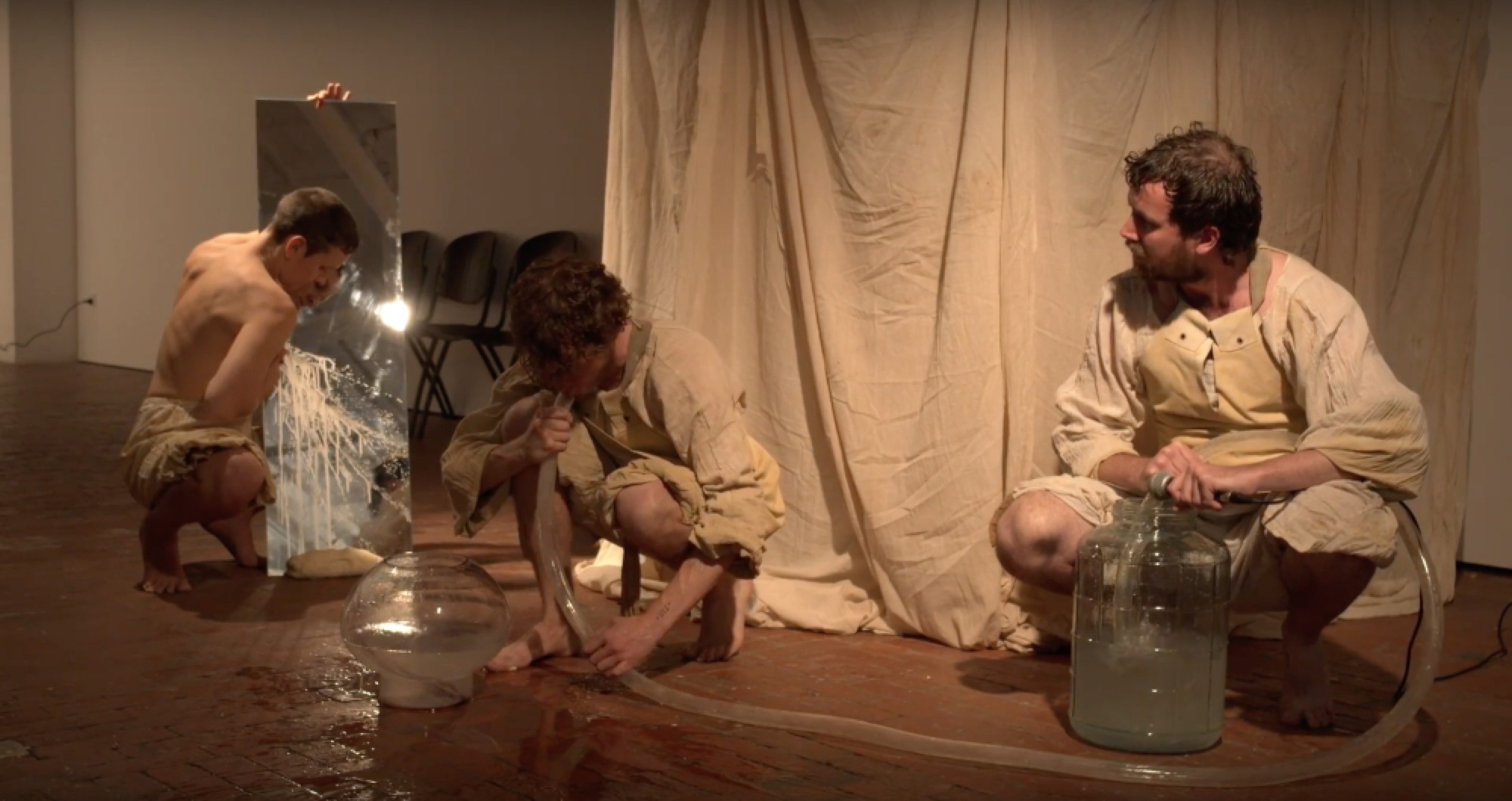
Water from the jar was added to the dough, now covered with breastmilk, which was then moved onto another nearby scene, where it was placed onto marble tiles on the floor. Here the dough was thoroughly kneaded by one of the performers. The ‘kneader’ simultaneously became the ‘kneadee’ as they were massaged by another artist, who took up position behind a free-hanging curtain—that staple form of some recent contemporary art in Melbourne—through which long gloves had been sewn as in a glove box: a sealed box whose contents can be manipulated without contamination. This massage-kneading was involved and labour intensive. While the two forms of massage were going on, the third performer carefully arranged lights on the floor within hollowed-out loaves of bread. Once the dough and the performer were satisfactorily kneaded and/or massaged, the performers took turns to shape and smooth the dough into loaves. These loaves were placed onto the floor. One performer carefully rested the others on these soft dough pillows in the (human) bodily hieroglyph of care: the recovery position. The performance over, the curtain was then shut on the viewers in less a gesture of theatrical closure than one of privacy or the end of a temporary exposure, as though the workings of the yeast and the dough would continue indefinitely in the basement of the Abbotsford Convent.
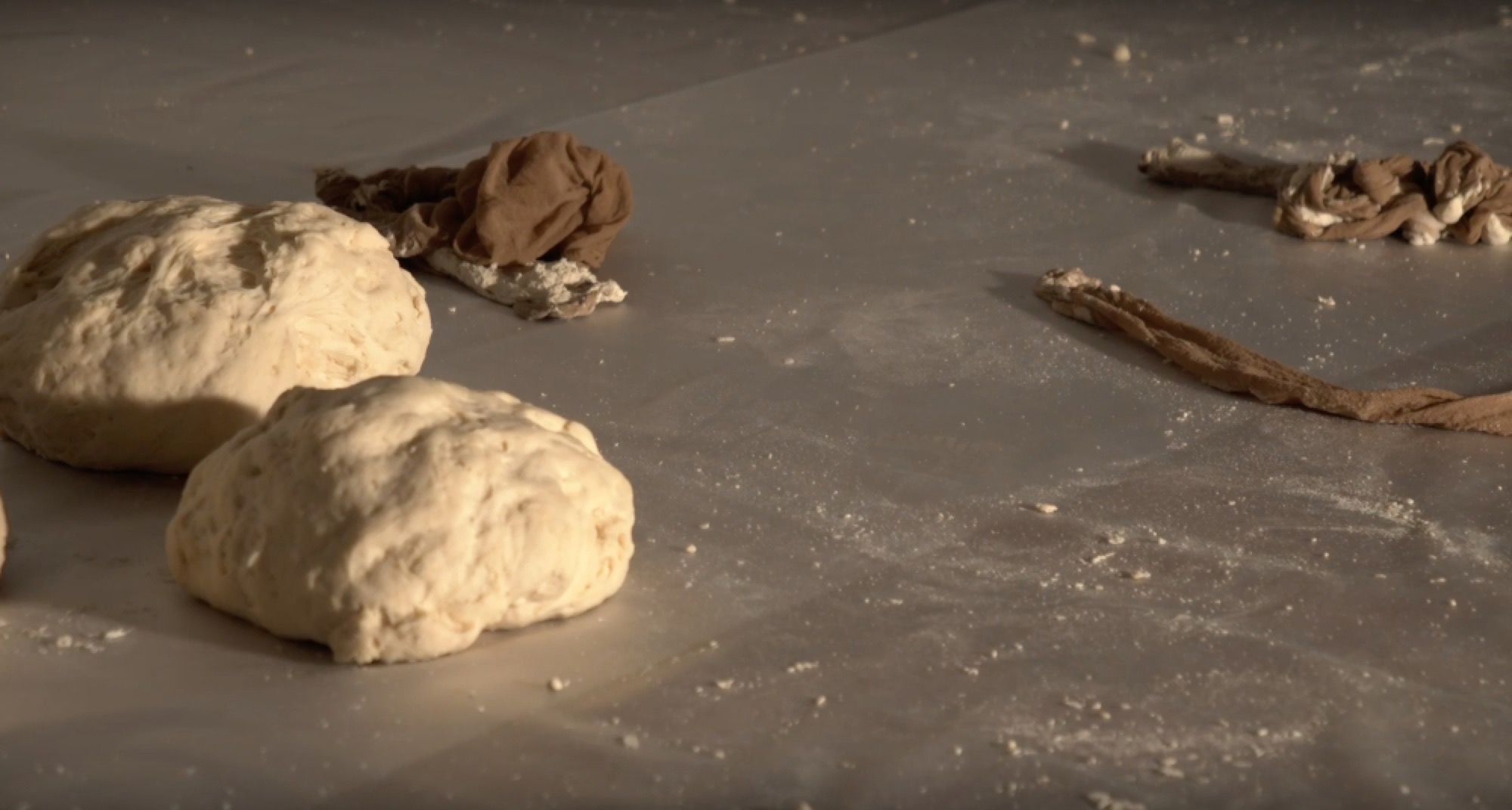
Part of me wants to avoid writing about Wet Nurse in terms of its theatricality and absorption, the tropes popularised by Michael Fried and set into an opposition by him. But in terms of performance, I think absorption illustrates a key aspect of the show. Fried’s argument is based on his analysis of 17th century French painting at the end of the Rococo period, which demonstrated a renewed interest in images depicting humans in a kind of absorptive focus with no apparent awareness of the audience whatsoever. These tropes were generally figures reading, thinking, writing, sleeping, and so on. The continual focused and laborious kneading of Wet Nurse can be added to this list.
Fried argued that theatricality and absorption remain distant and distinct: an artwork had to suspend the former to display the latter. In order to do this a distinction needs to be drawn between the content (the figure kneading) and the display (the performance itself). However, in a real—albeit microscopic—way, 110%’s performance is affected by the presence of the viewers: their coughs, skin fragments, bodily warmth and breath. The physical process and labour of Wet Nurse suggests a kind of joyous cross-contamination, an engrossed absorption in the rubbing and sharing of microbiological fungi and bacteria between microscopic body parts, breast milk and saliva. This absorptive contamination is happening between the performers and the apparently abstract, plastic forms of the dough that are nevertheless busy with their own process of life: fungal reproduction, feeding and appropriation going on invisibly within matter that is anything but inert but rather alive with millions of lives that are engaged and absorbed in their own aims.

On the human scale, the performers of Wet Nurse seemed driven by an almost compulsive exploration of the physicality of the dough and the support of the life that it contained. The soundtrack by Endurie—electronic dance music, occasionally glitchy but with a driving, persistent bpm—helped build this sense of complete focus on the process. The music also lent a further dimension to the performance: the double-massage of the performer-to-performer-to-dough reminded me of the kind of thing that might go on at a rave, where people come together to explore music, the physicality of dance and their bodies in deep absorbed focus, aided by chemicals or otherwise. The shellac-stained muslin clothing, the engrossed exploration and the symbolic and alchemical gestures made in the performance—the syphoning, the expression of breast milk, the fantastically abstract insertion of light-globes into bread—suggest a kind of psychedelic trance-process that reminded me at once of the films of Alejandro Jodorowsky and the epic imagery of the film Koyaanisqatsi.
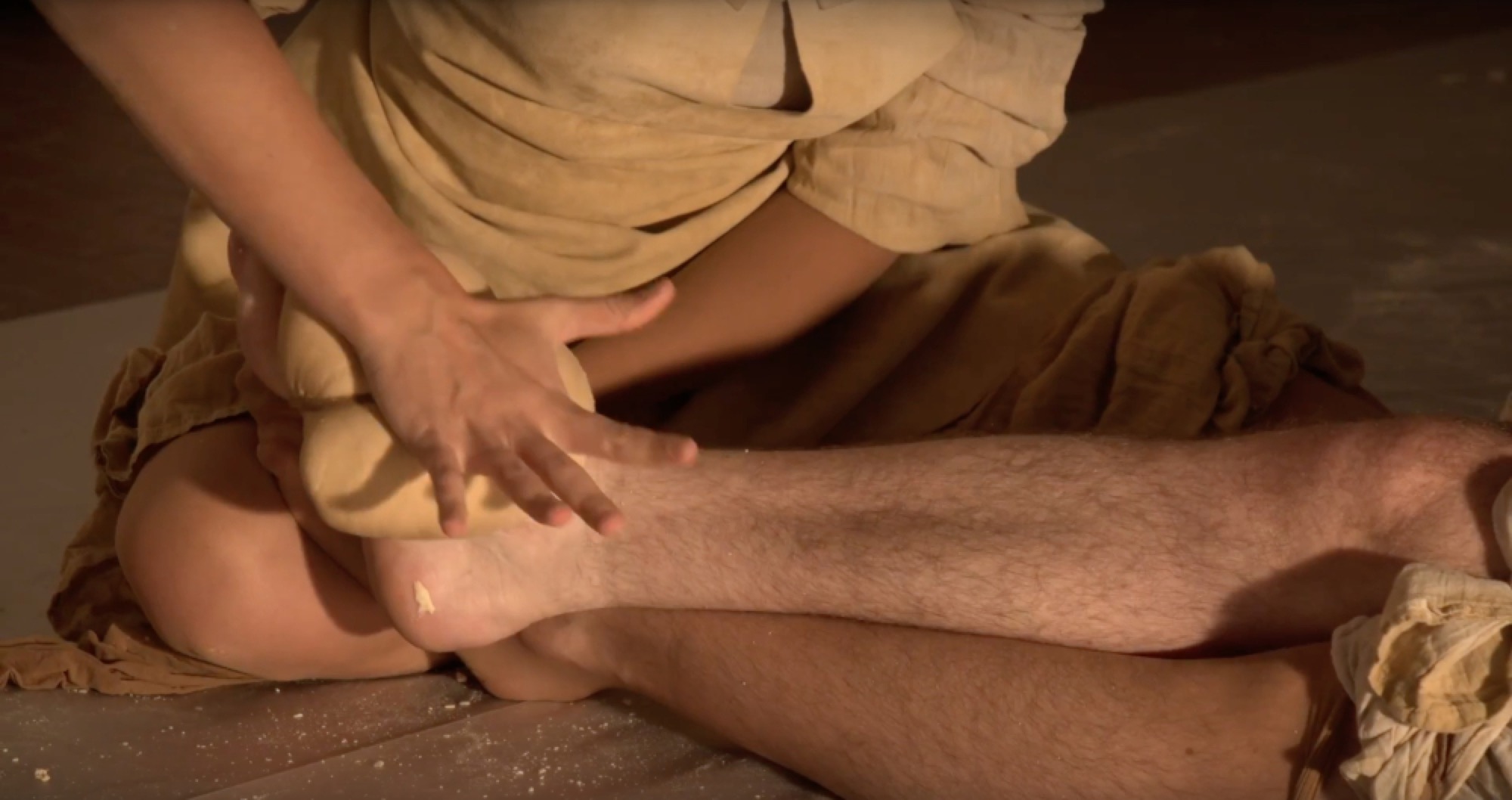
The idea of millions upon millions of yeast fungi living, reproducing and dying in the middle of an artwork does suggest a kind of epic activity. Many artists involve the labour and activity of non-human organisms in their work: the labour of bees or other insects and even the work of cancer cells come to occupy key spaces within an exhibition or installation. These gestures become a sign of apparent humility in the face of the grotesque scale of human intentionality at the Anthropocene level. They could also be understood as a kind of stand-offish intentionality, or perhaps cynically, as an outsourcing of movement, dynamism or decision-making in much the same way that performance art is often used as a way to ‘activate’ an exhibition space or a series of object-based artworks.
The labour of animals, plants and fungi can form part of our explanations of the artists’ absorptive or inward-looking focus. The obsessive and instinctive gestures of an artist become less the product of an internal existential state, tormented or otherwise, than the nurturing of our omnipresent microbial and fungal companions.

110% and their exploration of yeast fungi raise the issue of human (un)importance in a way that stresses the symbiotic relations between the animal and the non-animal. The contaminated, messy, wet and dirty provide a fertile ground for the microbial life both within us and around us. These ideas raise highly interesting questions about the boundaries and edges of the human/non-human and where we draw these lines. Furthermore, Wet Nurse asks us to consider what our relationship is between the non-human—not only animals and plants, but fungi as well—and the labour of the non-human. Bees and their labour in pollination, the production of wax and honey are tangible examples, as is the yeast used in bread and beer. The labour of fungi can also be used to decompose plastic and oils, and the symbiotic relations it develops and builds within soil led to the evolution of plant life on earth.
The symbiotic activity between fungi and animals suggests a profound causal possibility that could be used within the cause and effect structures so favoured in our thinking about art. Once anthropocentrism is put aside, the possibility emerges that all human activity could have as its telos the exhumation and reorganisation of materials and substrates for fungi. Could it be, like the plot of an absurdist Kurt Vonnegut novel, that the fungi are farming us?
David Wlazlo is a PhD Candidate in Art History and Theory at Monash University.

